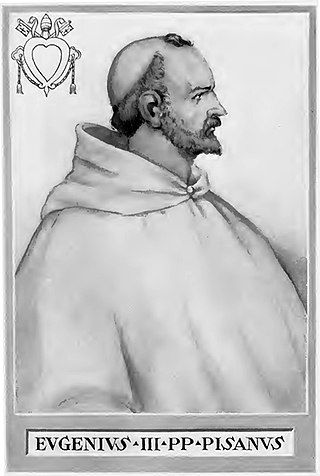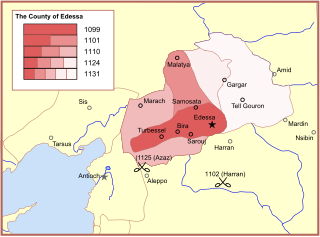
Year 1145 (MCXLV) was a common year starting on Monday of the Julian calendar.

The County of Edessa was a 12th-century Crusader state in Upper Mesopotamia. Its seat was the city of Edessa.

Edessa was an ancient city (polis) in Upper Mesopotamia, in what is now Urfa or Şanlıurfa, Turkey. It was founded during the Hellenistic period by King Seleucus I Nicator, founder of the Seleucid Empire. It later became capital of the Kingdom of Osroene, and continued as capital of the Roman province of Osroene. In Late Antiquity, it became a prominent center of Christian learning and seat of the Catechetical School of Edessa. During the Crusades, it was the capital of the County of Edessa.

Joscelin II was the fourth and last ruling count of Edessa. He was son of his predecessor, Joscelin I, and Beatrice, daughter of Constantine I of Armenia.

The siege of Edessa took place from 28 November to 24 December 1144, resulting in the fall of the capital of the County of Edessa to Zengi, the atabeg of Mosul and Aleppo. This event was the catalyst for the Second Crusade.

Syriac literature is literature in the Syriac language. It is a tradition going back to the Late Antiquity. It is strongly associated with Syriac Christianity.
Saint Michael the Syrian ,(Classical Syriac: ܡܺܝܟ݂ܳܐܝܶܠ ܣܽܘܪܝܳܝܳܐ, romanized: Mīkhoʾēl Sūryoyo), died 1199 AD, also known as Michael the Great or Michael Syrus or Michael the Elder, to distinguish him from his nephew, was a patriarch and saint of the Syriac Orthodox Church from 1166 to 1199. He is best known today as the author of the largest medieval Chronicle, which he wrote in the Syriac language. Some other works and fragments written by him have also survived.
Ignatius Isaac II was the Patriarch of Antioch and head of the Syriac Orthodox Church from 1709 until his resignation in 1723.
Ignatius Behnam Hadloyo was the Patriarch of Antioch and head of the Syriac Orthodox Church from 1445 until his death in 1454.
The Chronicle of 1234 is an anonymous West Syriac universal history from Creation until 1234. The unknown author was probably from Edessa. The Chronicle only survives in fragments, from which it is known to be divided into two parts: the first on ecclesiastical history, the second on secular. It was critically edited and translated by the French Orientalist Jean-Baptiste Chabot in 1920 and by Albert Abouna in 1974.
Çakırhüyük is a town (belde) and municipality in the Besni District, Adıyaman Province, Turkey. Its population is 2,210 (2021).
Athanasius VI bar Khamoro was the Patriarch of Antioch, and head of the Syriac Orthodox Church from 1091 until his death in 1129.
John XI bar Mawdyono, also known as Yuhanna Modyana, was the Patriarch of Antioch, and head of the Syriac Orthodox Church from 1130 until his death in 1137.
Athanasius VII bar Qatra was the Patriarch of Antioch, and head of the Syriac Orthodox Church from 1139 until his death in 1166.
The Chronicle of 846 is a fragmentary universal chronicle written in Syriac by an anonymous author sometime between 846 and 873. Its focus for the later centuries, where it is most valuable, is ecclesiastical history. It is written from a Syriac Orthodox perspective.

The siege of Edessa in October–November 1146 marked the permanent end of the rule of the Frankish Counts of Edessa in the city on the eve of the Second Crusade. It was the second siege the city had suffered in as many years, the first siege of Edessa having ended in December 1144. In 1146, Joscelyn II of Edessa and Baldwin of Marash recaptured the city by stealth but could not take or even properly besiege the citadel. After a brief counter-siege, Zangid governor Nūr al-Dīn took the city. The population was massacred and the walls razed. This victory was pivotal in the rise of Nūr al-Dīn and the decline of the Christian city of Edessa.
Theodorosbar Wahbun was a Syriac Orthodox monk and writer who was elected patriarch of Antioch in 1180 in opposition to the reigning patriarch, Michael Rabo. Using the name John, he continued as an anti-patriarch in exile until his death. He pursued ecumenism and the union of the churches.
The Lordship of Marash was a territorial lordship in northeastern Cilicia between 1104 and 1149, centred on the city of Marash. One of the lesser Crusader states, it played a major role in the defence of the northern frontier in the 1130s and 1140s under Lords Geoffrey and Baldwin. Its position became untenable after the fall of Edessa in 1146.

The (arch)diocese of Hierapolis in Syria was the metropolitan bishopric of the ecclesiastical province of the Euphratensis. It was based in the city of Hierapolis in Syria. It was traditionally the fifth see in dignity under the Patriarch of Antioch. Under the Patriarch Athanasius I in the sixth century, it had nine suffragan bishoprics.
The Mor Bar Sauma Monastery was a Syriac Orthodox monastery near Malatya in Turkey. The monastery served as the regular patriarchal residence from the eleventh century until the thirteenth century, and was eventually abandoned in the seventeenth century. It produced five patriarchs and forty-three metropolitan bishops. Between 1074 and 1283 several synods took place at the monastery.